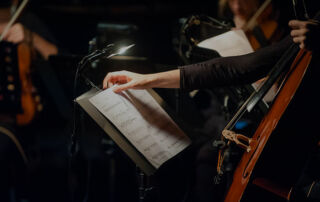Why is my teacher constantly hammering on using the fingering correctly as given without fail?
When talking about fingering I refer to the fingering given in a written or practised piece of music, especially in the classical style. As students of piano music know, numbers 1 to 5 are allocated for each hand. The 1st number is for the thumbs.
When playing your piano piece only the essential numbers for fingers will be written on the score. It's quite “busy” and disturbing to play from a sheet of music where every single finger has been written in. Do refrain from writing in every finger if you are studying a score.
The question is why is fingering so important?
“Do I really have to use this or that finger when the closest or easiest finger I want to use, feels better?“
We all sooner or later find out that the fingering given (by a trusted editor) is usually the best. These days, however, you often find music on google where fingering is done by a novice which leads you to struggle in playing the piece well. Make sure you use a good edition - like Artur Schnabel or Schirmer or the Peters edition etc. The older trusted versions are still the best.
Let's get to the reason why your teacher will be so strict about using the correct fingering each time.
Fingering helps your playing in the following ways:
- It gives structure and surety of how you will execute a line or a phrase.
- Being constant in using the same fingering on a passage means that your muscles soon learn how to play a passage and it becomes natural after a while. We call it muscle memory.
- It helps to be able to play your piece with ease when you do the trouble to specifically give attention to the correct fingering at all times.
- Practise the use of the same fingers continually.
- Using the same fingering helps with playing your piece from memory quicker.
- Knowing and practising with the correct fingering increases your speed and ability to play passages.
- The most important point is that each finger has a different physiognomy and choosing one finger over another will change your sound production.
I cannot stress the use of good fingering enough to students. It is the answer to many mistakes which often are repeatedly occurring.
Do you have a passage where you simply can not understand why you always break down when playing? It's most probably a fingering problem. Follow this solution:
- Stop your playing.
- Break the passage or bar up to a very slow - or rather dead slow speed with each hand separately.
- Pinpoint exactly where the mistake comes in.
- Correct any fingers that might be wrong. Practice the correct fingering very slowly and securely for at least 7 times. Each time needs to be flawless in order to correct the problem. I find that if I could repeat it 7 times consecutively and flawlessly, the problem is usually rectified. If you breakdown every now and then, all the repetition will not help.
- Use total concentration while practising to correct the fingering.
Often students tend to change fingers every time they play a passage. This will very definitely not help your performance at all! It will kill it and you can be sure of a breakdown. My advice is to take the time to learn the correct fingering and lines so that you can flow in your playing of the piece and enjoy it! That's our main goal -to enjoy playing.
Unfortunately, like with any other project - there is always ground or root work to be done which needs to be perfected. It's like building something without good foundations.
Good fingering is part of this strong foundation needed to play a piece of music well.
Unfortunately, there are no shortcuts to correct fingering!
- It's important not to try to get out of uneasy fingering - (unless there is a mistake of course). Many times a phrase dictates a specific fingering because of a continuous legato line which is needed.
- Fingering is always chosen in such a way that the player uses the best and easiest fingers available.
- Putting a thumb under or using a stretch between fingers is sometimes needed to reach where the phrase leads to.
- Slow practice is needed to make sure that everything is done perfectly and also the use of the wrist or arm may help with practising difficult passages.
Playing scale passages:
If there is a scale passage in a certain key, it's natural to use the fingering for the scales that you already know. It makes playing a bit easier. Sometimes, because of the way the passage moves. it is not possible, but most times it's best to use the known scale fingering. The same is true for arpeggio passages.
Playing repeated notes:
When playing repeated notes, one often wants to just ignore the “stupid” changing of fingers on one note, but it is super important for fast, precise and secure playing of repeated notes! We all tried to ignore this and do it with the same finger - just soon to find out that the passage is not “clean” and clear and the repeated note gets “stuck”!
Effects of learning wrong fingering:
I once practised a difficult or rather, a tricky passage in Beethoven's Fur Elize: The right hand has a passage where there is a lot of continuous movement from the thumb back to the pinkie. In the written score the fingering moved from the thumb to the pinkie then to the 2nd finger and to the pinkie and back again to the thumb etc. I was a bit frustrated with the changing of the thumb and 2nd finger and thought it best just to stick to the easier version of only using the thumb. Well needless to say - the faster I started to play this passage the more I struggled at that point!
At some stage, I had to stop everything, correct the passage, and learn the proper fingering. Well, It took me many weeks to be able to erase the wrong fingering which was now well drilled into my muscle memory. After quite a time, I could eventually “erase” the easy but not effective fingering with which I tried to get away!
Unless you know that your fingering is better, it's best to stay with the fingering given on your trusted sheet music.
Aspects of weight, the strength of fingers used, movement of the passage from one point to another, playing loudly or softly, etc. are all taken into mind when fingering is done.
As a final word on fingering:
Using good fingering, slowly but very accurately following the correct fingering while learning your piece is the best way if you want to play effortlessly and enjoy your piece!
- Do the trouble and painstakingly at a seriously slow speed unravel your passages.
- Learn their movement - giving 100% attention to using the same correct fingering each time!
- It pays off!
What a pleasure to be able to execute a difficult passage with ease! Only - by using constant good fingering!
Enjoy fingering! It is quite an art to work out fingering and the flow of a passage. Ask yourself: “Why would they be using this finger now?” Usually, there is an obvious answer. Or rather there is always a very good reason for fingering in a specific way, especially in the well-trusted editions. Enjoy!






